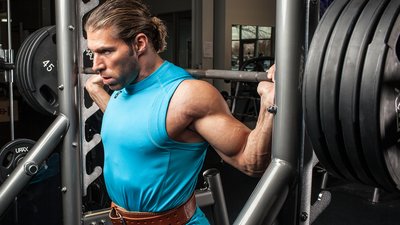If a beginner learns anything in the weight room, it's that leg training is hard. In fact, it's tougher than pretty much any other muscle group. This realization causes many lifters to avoid leg training altogether and start focusing on their upper body instead. Throw a few sets of leg extensions and leg curls in there, and you're good to go, right? Only if you want to be that guy at the gym wearing pants in front of the mirror while training arms!
No, squats aren't easy, and they never will be. But maybe part of why you're avoiding them is because you don't have the right program to guide you! If so, this is the program you've been waiting for.
Any of the four workouts below can be plugged into your existing program to help you get better at the squat and improve your leg development, or you can run them in a progression like this:
Phase 1: 6-8 weeks
- Once a week: Glute-focused leg workout
- 3-4 days later: Quad-focused leg workout
Phase 2: 6-8 weeks
- Once a week: Overall leg-mass workout
- 3-4 days later: Hamstring-focused leg workout
That's about three months of tough twice-a-week leg training. Eat enough calories and get enough protein, and your legs—and probably a few other muscle groups—will show it. You're welcome!
Mass Training For Legs Made Simple
When you're a beginner doing full-body workouts, the focus is usually on getting familiar with movements, nailing down your form, and hitting some basic strength benchmarks. Once you graduate to a split like upper/lower or push/pull/legs, it's all about building up your muscular foundation, and no other leg exercise does that better than barbell squats. While it's tempting to want to find a less difficult option, every workout here includes some version of the squat—usually first in the workout—because they can't be beat for building leg strength and size.
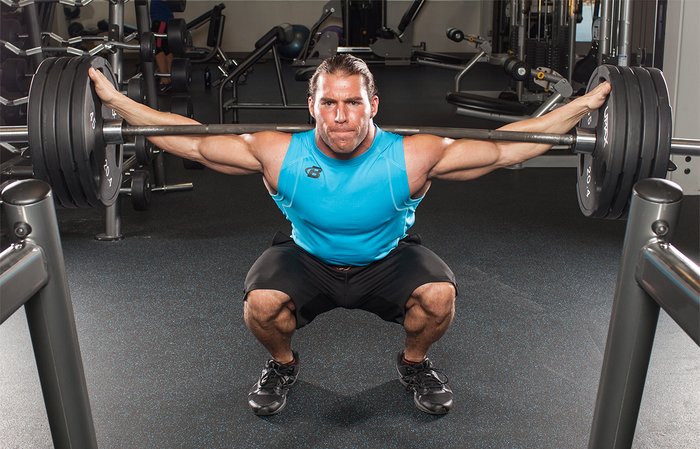
If you've been avoiding squats, this is the program you've been waiting for.
While you may not have found a need for warm-up sets as a beginner, they become more important the more advanced you become, primarily because you'll be stronger on a movement if you've preceded it with a few light-weight sets first. So don't just jump right into your heaviest 1-2 sets. Take as much time and as many sets as you need to feel warm and strong.
One more note about programming: Many programs follow a pyramid set-up in which you use increasingly heavier weight on successive sets, but the ones below are instead based on reverse pyramids in which you to take more total sets to failure.
Essentially, after warming up well, you go right to your heaviest 1-2 sets, reducing the weight on follow-up sets to account for accumulating fatigue. Reduce the weight by about 5-10 percent, which is indicated in the workouts by the higher rep target.
For all four leg workouts, follow these tips:
- The workouts don't include warm-up sets. Perform as many as you need, but never take your warm-ups anywhere near muscle failure.
- After warm-ups, choose a weight that allows you to reach muscle failure by the target rep listed. The rep sequence for each exercise follows a reverse pyramid, meaning you lighten the weight a bit for slightly higher reps on each set after your first 1-2 sets. It's important to take each set close to muscle failure.
1. Mass-Building Glute-Focused Workout
The barbell back squat is a great overall leg builder, but the deeper you go, the more your glutes will benefit. Strive to descend to a point at which your thighs are at least parallel with the floor. The basic squat is a rather technical lift, so invest in learning how to do it right and get feedback from an experienced trainer or coach. After all, you'll be doing this basic movement for the life of your lifting career.
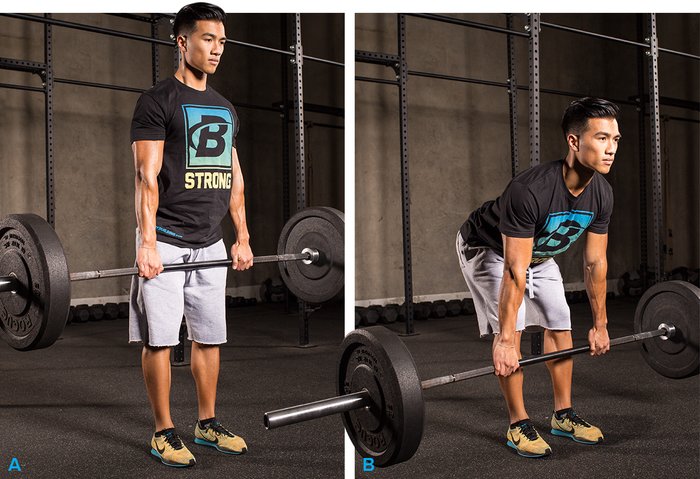
Romanian Deadlift
Remember, you're following a reverse-pyramid approach for all movements, with your first exercise tilted to the lower end of the hypertrophy range for a bit more strength stimulus. This reverse pyramid allows you to take more total sets to muscle failure.
2. Mass-Building Quad-Focused Workout
You'll perform a whole new batch of exercises here. The front squat and these other leg movements selectively work the quads to a greater degree than the glutes. The front squat is still a highly challenging movement, though, so keep it at the front end of your workout.
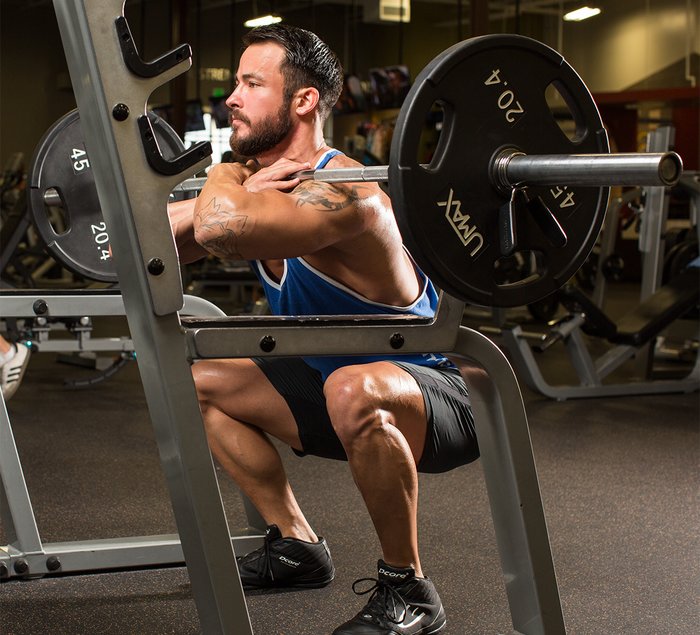
Barbell Squat
The leg press offers numerous options of foot positions and stances, each with different results. If you go fairly low on the platform with your feet about hip-width apart, you'll effectively emphasize the quads over the glutes.
To balance out leg day, you'll finish off your quads on the leg extension, followed by single moves for the hamstrings and calves. This may be a quad-focused workout, but it's not quad-only!
3. Mass-Building Leg Workout
This is a straightforward overall leg routine that hits both the quads and glutes fairly effectively. Again you'll start with squats, this time with a bit more volume to add variety, but after that, it's all machines. With those—especially the hack and leg press— you can use multiple foot positions on the foot sled to alternate emphasis on the glutes and hams on one set, and then onto the quads the next.

Hack Squat
Most people find they're stronger on those sets in which the foot position emphasizes the glutes, but you'll benefit from doing it both ways. I recommend trying two sets of each variation for both the hack and leg press.
One other benefit of machines: You can push yourself a little closer to muscle failure without having to balance a weight. In that sense, you're likely to get a bit more overall volume with this workout.
4. Hamstring-Focused Leg Workout
Many trainees regard hamstrings training with the same out-of-sight, out-of-mind training philosophy they apply to their backs. Big mistake.
As you progress, you don't want your quad strength to dominate your hamstrings, because they're antagonistic muscles around the same knee joint. Both work to stabilize and support the knee. If the quad is too much stronger than the hams, you increase your risk of a knee injury—and that's even more common in women. In terms of a ratio for optimal knee health, your quads should be stronger than your hams by no more than about a 3:2 ratio.
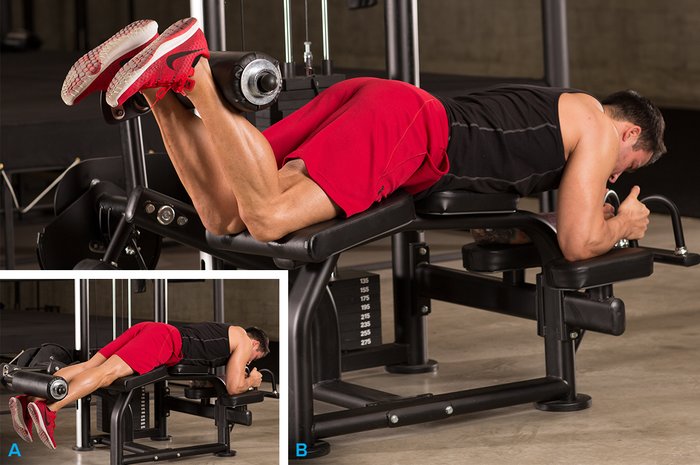
Lying Leg Curl
You'll see two hamstrings movements in this workout: a leg-curl movement, which better emphasizes the lower region of the hamstrings above the knee, and the upper-hams-focused Romanian deadlift, which makes a nice complementary move. You'll do both hamstrings movements first in your workout, to prefatigue the hamstrings, before doing your squats in the more stable Smith machine afterward.


